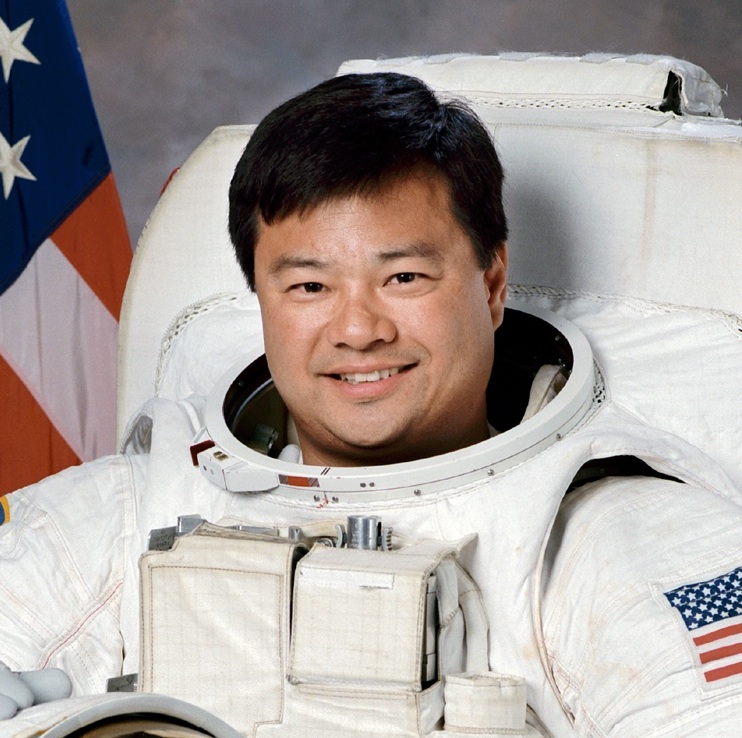
Sputnik Turns 60: Astronaut Leroy Chiao Celebrates 1st Satellite

Leroy Chiao is the CEO and co-founder of OneOrbit LLC, a motivational, training and education company. He served as a NASA astronaut from 1990 to 2005 and flew four missions into space, as a crewmember aboard three space shuttles and as the co-pilot of one Russian Soyuz spacecraft launched to the International Space Station. After that flight, he served as the commander of the station's Expedition 10, a 6.5-month mission. Chiao has performed six spacewalks, in both U.S. and Russian spacesuits, and has logged a total of 229 days in space. Chiao contributed this article to Space.com's Expert Voices: Op-Ed & Insights.
It has been 60 years since the Soviet Union launched Sputnik 1, Earth's first artificial satellite.
English-language dictionaries often define the word "sputnik" as the Russian term for a "fellow traveler," but the meaning of the word is much more specific. It refers to a person with whom one is traveling, perhaps by accident or coincidence, on a long voyage or journey. This was certainly an appropriate name, considering that satellites became and continue to be an important part of our everyday lives. The journey continues.
Although Sputnik 1 contained only a simple radio transmitter that broadcast a beeping signal, the spacecraft marked the dawn of space utilization and exploration. It also represented the awesome military potential and threat of controlling the "high ground" of space. The nightmare scenario was that one or more countries would orbit a network of weapons, nuclear or otherwise, to rain destruction down upon enemies at will. Fortunately, the major powers of the world decided that this was too dangerous and signed treaties agreeing to ban such weapons. [Sputnik 1: World's 1st Artificial Satellite Explained (Infographic)]
Today, Earth orbits are filled with communications satellites, global-positioning satellites of differing flavors (the U.S., Russia, Europe and China all have their own constellations of such spacecraft), spy satellites (optical, electronic and others), and Earth-observation satellites (including weather satellites), just to name a few. Several companies are also working on global internet satellites, small constellations of Earth-mapping satellites and other small satellites. As technology improvements enable smaller and lighter satellites, expect the number of spacecraft and applications to grow significantly.
This can be a problem. Orbital debris is considered the most likely and most dangerous threat to active spacecraft. Old satellites in geostationary orbit use the last bits of their fuel to go to a "graveyard orbit" high above the operational altitudes of other such satellites. However, most of the newer, smaller satellites will be launched to low Earth orbit (LEO), where the International Space Station and other crewed vehicles operate. Regulations and agreements will be needed to ensure that these satellites will be deorbited safely to burn up in the atmosphere when they are finished with their missions. But, furthering the problem, these small satellites are difficult, and in some cases not yet possible, to track. We will have to figure that out.
Sputnik 1 paved the way not only for other satellites, but also for human spaceflight. Just a few years after Sputnik 1 left Earth, Yuri Gagarin was launched into orbit, proving that humans could live and work in space. Eight years later, Apollo 11 landed astronauts on the moon. To quote the tagline from "The Right Stuff," one of my favorite films, "This is how the future began."
Get the Space.com Newsletter
Breaking space news, the latest updates on rocket launches, skywatching events and more!
You can read more of Chiao's Expert Voices Op-Eds and film reviews on his Space.com landing page. Follow us @Spacedotcom, Facebook and Google+. Original article on Space.com.
Join our Space Forums to keep talking space on the latest missions, night sky and more! And if you have a news tip, correction or comment, let us know at: community@space.com.
Leroy Chiao is a former NASA astronaut and International Space Station (ISS) commander. Chiao holds appointments at Rice University and the Baylor College of Medicine. Chiao has worked extensively in both government and commercial space programs, and has held leadership positions in commercial ventures and NASA. Chiao is a fellow of the Explorers Club, and a member of the International Academy of Astronautics and the Committee of 100. Chiao also serves in various capacities to further space education. In his 15 years with NASA, Chiao logged more than 229 days in space, more than 36 hours spent in Extra-Vehicular Activity (spacewalks). From June to September 2009, he served as a member of the White House appointed Review of U.S. Human Spaceflight Plans Committee, and currently serves on the NASA Advisory Council. Chiao studied chemical engineering at the University of California, Berkeley, earning a Bachelor of Science degree in 1983. He continued his studies at the University of California at Santa Barbara, earning his Master of Science and Doctor of Philosophy degrees in 1985 and 1987. Prior to joining NASA in 1990, he worked as a research engineer at Hexcel Corp. and then at the U.S. Department of Energy's Lawrence Livermore National Lab. Dr. Chiao left NASA in December, 2005 following a 15-year career with the agency. Chiao studied chemical engineering at the University of California, Berkeley, earning a Bachelor of Science degree in 1983. He continued his studies at the University of California at Santa Barbara, earning his Master of Science and Doctor of Philosophy degrees in 1985 and 1987. Prior to joining NASA in 1990, he worked as a research engineer at Hexcel Corp. and then at the U.S. Department of Energy's Lawrence Livermore National Lab.

